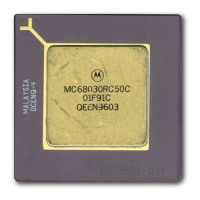Introduction
MOTOROLA
MC68030 USER’S MANUAL
1-7
The program counter (PC) contains the address of the next instruction to be executed by the
MC68030. During instruction execution and exception processing, the processor
automatically increments the contents of the PC or places a new value in the PC, as
appropriate.
The status register, SR, (see Figure 1-4) stores the processor status. It contains the
condition codes that reflect the results of a previous operation and can be used for
conditional instruction execution in a program. The condition codes are extend (X), negative
(N), zero (Z), overflow (V), and carry (C). The user byte containing the condition codes is the
only portion of the status register information available in the user privilege level, and it is
referenced as the CCR in user programs. In the supervisor privilege level, software can
access the full status register, including the interrupt priority mask (three bits) as well as
additional control bits. These bits indicate whether the processor is in:
1. One of two trace modes (T1, T0)
2. Supervisor or user privilege level (S)
3. Master or interrupt mode (M)
The vector base register (VBR) contains the base address of the exception vector table in
memory. The displacement of an exception vector is added to the value in this register to
access the vector table.
Figure 1-3. Supervisor Programming Model Supplement
31
16 15
0
31
16 15
0
15
87 0
(CCR) SR
A7" (MSP)
A7' (ISP)
31
0
VBR
SFC
DFC
CACR
CAAR
INTERRUPT
STACK POINTER
MASTER STACK
POINTER
STATUS REGISTER
VECTOR BASE
REGISTER
ALTERNATE FUNCTION
CODE REGISTERS
CACHE CONTROL
REGISTER
CACHE ADDRESS
REGISTER
0
0
0
31
31
31
AC0
ACCESS
CONTROL
REGISTER 0
0
31
AC1
ACCESS
CONTROL
REGISTER 1
0
31
ACUSR
ACU STATUS
REGISTER
0
15

